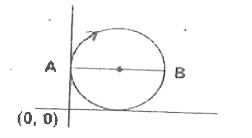A particle moves in a circular path of radius 4 m with constant speed πm/s. Another particle starts from rest with acceleration 0.25m/s2? and moves along diameter to and fro again and again. The second particle takes 1 sec to make a 180∘ turn every time. Both particles start from the same point A. Then they meet first time after n diametric moves of second particle. Find the value of n.

The correct Answer is:5
Step by step video, text & image solution for A particle moves in a circular path of radius 4 m with constant speed pi m//s. Another particle starts from rest with acceleration 0.25 m//s^(2)? and moves along diameter to and fro again and again. The second particle takes 1 sec to make a 180^(@) turn every time. Both particles start from the same point A. Then they meet first time after n diametric moves of second particle. Find the value of n. by Physics experts to help you in doubts & scoring excellent marks in Class 12 exams.
Topper's Solved these Questions
- BOOK - FIITJEECHAPTER - KINEMATICSEXERCISE - SECTION(I): MCQ (SINGLE CORRECT)120videos
KINEMATICS
- BOOK - FIITJEECHAPTER - KINEMATICSEXERCISE - SECTION (II) : (SUBJECTIVE )33videos
KINEMATICS
- BOOK - FIITJEECHAPTER - KINEMATICSEXERCISE - ASSIGNMENT PROBLEMS (OBJECTIVE) LEVEL-II (MATRIX MATCH TYPE)4videos
KINEMATICS
- BOOK - FIITJEECHAPTER - HEAT AND TEMPERATUREEXERCISE - NUMERICAL BASES QUESTIONS1videos
HEAT AND TEMPERATURE
- BOOK - FIITJEECHAPTER - LAWS OF MOTIONEXERCISE - COMPREHENSION-III2videos
LAWS OF MOTION
Similar Questions
A particle is revolving in a circular path of radius 2 m with constant angular speed 4 rad/s. The angular acceleration of particle is
View SolutionA particle is moving on a circular path of radius 1 m with 2 m/s. If speed starts increasing at a rate of 2m/s2, then acceleration of particle is
View Solution
Knowledge Check
- Question 1 - Select One
If a particle is moving along a circle of radius 3 m with a constant speed 9m/s, then it covers a quarter of the circle in time of
Aπ/3sBπ/6sCπ/2sDπ/8s - Question 2 - Select One
A particle is moving along circular path of radius 40 m with a uniform speed of 20m/s. Then the time taken for the particle to complete half revolution will be
A4πsBπsC2πsDπ/2s - Question 3 - Select One
A particle starts from rest with uniform acceleration a. Its velocity after n seconds is v. The displacement of the particle in the two seconds is :
A2v(n−1)nBv(n−1)nCv(n+1)nD2v(2n+1)n
A particle starts from rest and moves with an acceleration of a={2+|t−2|}m/s2 The velocity of the particle at t=4 sec is
View SolutionA particle is moving along a circular path of radius 5 m with uniform speed of 5m/s. What will be time taken by the particle in half revolution?
View SolutionA particle moves in a circular path of radius 0.4 m with a constan speed . If it makes 5 revolution in each second of its motion , then the speed of the particle will be
View SolutionA particle moves in a circle of radius 2 m at a second
what is its resultant (total ) acceleration at time t=1 s ?View SolutionA particle starts moving with acceleration 2m/s2. Distance travelled by it in 5th half second is
View Solution

